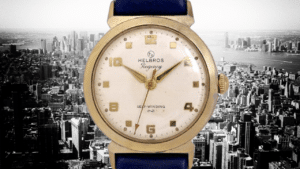The History of the Helbros Watch Company
In 1913, brothers William and Julius Helbein set out to make a bold statement in watchmaking: quality timepieces didn’t have to be reserved for the elite. The Helbein brothers, whose company name would become the now-iconic “Helbros”—a blend of their surname and family legacy—believed that craftsmanship, style, and precision could be accessible to everyone. What started as an ambitious idea in New York City would evolve into a brand that not only adorned the wrists of the working class but also made its mark on horological history through innovation, affordability, and adaptability.
In the early 20th century, wristwatches were just beginning to eclipse pocket watches in popularity. William and Julius seized the moment, building a company focused on designing watches that married quality and affordability. By the 1920s, Helbros was already pioneering bold marketing strategies, showcasing their watches through extensive advertising campaigns in newspapers and magazines. As the world entered the era of radio and television, Helbros quickly adapted, pushing their brand into households across America and beyond. This forward-thinking approach made Helbros watches highly recognizable and affordable timepieces for the everyday consumer.
Helbros offered an impressive variety of watches over the years, with several standout models reflecting their craftsmanship, innovation, and design.
 The Regency Series, introduced in the 1930s, embodied timeless elegance with cases made from high-quality stainless steel or gold-plated brass. The dials featured clean and refined designs, with Arabic or Roman numerals and slender hands powered by reliable Swiss manual-wind movements. Many models also featured decorative guilloché patterns, enhancing their sophistication.
The Regency Series, introduced in the 1930s, embodied timeless elegance with cases made from high-quality stainless steel or gold-plated brass. The dials featured clean and refined designs, with Arabic or Roman numerals and slender hands powered by reliable Swiss manual-wind movements. Many models also featured decorative guilloché patterns, enhancing their sophistication.
 The Invincible Collection, launched in the 1940s, focused on durability, reliability, and affordability. Featuring sturdy chrome-plated or stainless steel cases, these watches were designed to endure daily wear and tear. The movements, such as robust 17-jewel Swiss manual-wind calibers, powered luminous dials with bold numerals for easy reading in low light.
The Invincible Collection, launched in the 1940s, focused on durability, reliability, and affordability. Featuring sturdy chrome-plated or stainless steel cases, these watches were designed to endure daily wear and tear. The movements, such as robust 17-jewel Swiss manual-wind calibers, powered luminous dials with bold numerals for easy reading in low light.
 Helbros produced military-style watches during World War II, which were known for their rugged durability and functionality. These watches featured stainless steel or nickel-plated cases, shatter-resistant acrylic crystals, and high-contrast black dials with luminous numerals and hands for enhanced legibility in tough conditions.
Helbros produced military-style watches during World War II, which were known for their rugged durability and functionality. These watches featured stainless steel or nickel-plated cases, shatter-resistant acrylic crystals, and high-contrast black dials with luminous numerals and hands for enhanced legibility in tough conditions.
In the 1960s, Helbros introduced their innovative Lunar Phase Watch, which displayed not only the time but also the phases of the moon—a rare complication for the era. Housed in polished stainless steel cases with domed acrylic crystals, these timepieces often featured Swiss-made manual-wind or automatic movements with 17 or 21 jewels. The dials were beautifully designed, with moon phase displays set against elegant hands and indices. The Lunar Phase models reflected Helbros’ ability to combine functionality with aesthetic appeal, standing out as some of their most unique creations.
 The Helbros Mickey Mouse Watch became one of their most iconic timepieces. These watches were popularized during the mid-20th century under license from Walt Disney Productions. Featuring colorful dials with Mickey Mouse’s arms serving as the hour and minute hands, these whimsical watches came in child and adult sizes, housed in nickel or chrome-plated cases with leather straps. Powered by dependable manual-wind Swiss movements, they combined charm with craftsmanship and remain highly sought-after collectibles today.
The Helbros Mickey Mouse Watch became one of their most iconic timepieces. These watches were popularized during the mid-20th century under license from Walt Disney Productions. Featuring colorful dials with Mickey Mouse’s arms serving as the hour and minute hands, these whimsical watches came in child and adult sizes, housed in nickel or chrome-plated cases with leather straps. Powered by dependable manual-wind Swiss movements, they combined charm with craftsmanship and remain highly sought-after collectibles today.
A critical part of Helbros’ success lay in their ability to produce watches on a large scale without compromising quality. To support this, Helbros relied on manufacturing partnerships in Switzerland, where much of their production was centered. This connection to Switzerland enhanced their reputation for producing watches that could compete with European brands while remaining affordable for a wider audience.
After World War II, Helbros continued to innovate and diversify their product offerings, capitalizing on their established reputation for reliability.
Helbros’ success wasn’t just in their designs but in their ability to adapt to changing times. The 1960s marked significant corporate changes, including their acquisition by the Elgin National Watch Company in 1963. Though Helbros operated as a division of Elgin, they retained their brand identity, and Larry Prigozen, a key figure in the company, remained at the helm as president. However, the passing of William Helbein in 1960 marked the beginning of a gradual decline. The quartz revolution of the 1970s brought inexpensive, highly accurate watches to the market, particularly from Japan, and Helbros struggled to compete with this wave of new technology. Coupled with increasing overseas competition and shifting consumer preferences, the company began to lose its foothold.
By the early 1970s, Helbros had ceased operations as a major player in the watch market. Their trademark changed hands several times, signaling the end of their golden era. Despite this, their legacy endured. Helbros watches, once the staple of everyday wear, became collectible pieces for enthusiasts drawn to their craftsmanship, style, and historical significance – Helbros timepieces offer a glimpse into a bygone era of American ingenuity.
Today, Helbros lives on through collectors and historians who cherish its contributions to watchmaking. The company’s ability to blend affordability with craftsmanship created a lasting impact, and its most iconic models remain timeless treasures. What started as a dream in 1913—to bring high-quality watches to the masses—resulted in a brand that, despite its eventual decline, earned its place in horological history. For those who stumble upon an old Helbros watch today, whether in an attic, estate sale, or collector’s showcase, there’s a timeless story ticking away inside—one of innovation, resilience, and a belief that a great watch should be within everyone’s reach. William and Julius Helbein may not have known how far their name would travel, but they left behind a legacy that continues to keep time, one tick at a time.

